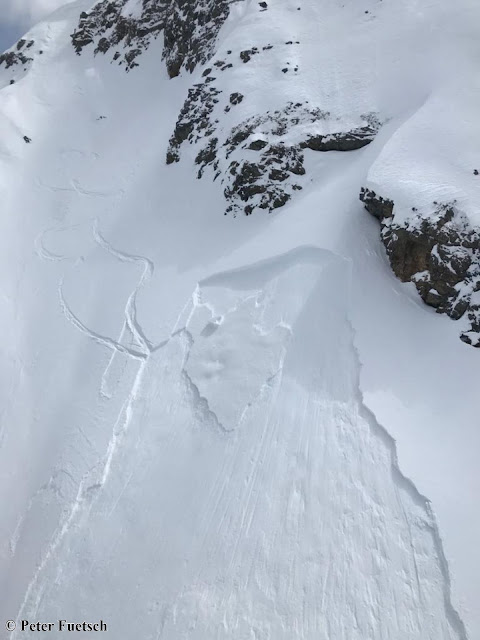Temperature progression...far removed from normal
Yes, this is April, and April is well known for capricious weather. Even taking that into consideration, we gaze back on a highly ususual sequence of temperature development. Let’s permit an expert at ZAMG Weather Service, Alexander Radlherr, to elucidate just what happened:
“The ups and downs in temperature were rather extreme this year. A week ago, just days after the latest striking re-entry of winter, record-breaking high temperatures were registered in many measurement stations in Tirol (including those with long meauring histories) for the month of March. On 07.04.2021 at some stations, a short series of record-breaking lows for April was reached. On the same days of April 2003 it was 1 to 2 degrees colder at high altitudes, although these were absolute record lows for the month of April at many of the ‘old’ measuring stations.
Tmax from 31.03.2021:
Innsbruck +25.5; measurements since 1877
Umhausen +21.5, measurements since 1936
Brunnenkogel +3.1, measurements since 2003
Tmin vom 07.04.2021:
Brunnenkogel -24.6 (old record -22.5 from 2015)
Just let that sink in. The huge extremes this winter were not merely a subjective feeling.”
 |
| Deviation of daily mid-temperature on 30.03.2021 (in the mountains this depiction shows a still more striking Maxima than on 31.03) |
 |
| Deviation from daily middle temperature on 07.04.2021 |
Effects on avalanche danger
To begin with, a wet-snow problem...
Until and including 02.04.2021 we were in a wet-snow avalanche cycle. At the middle of last week there were extremely warm temperatures measured, amplified by the effects of solar radiation, which were the cause of this. On 02.04, nocturnal rainfall and moist-warm weather accelerated snowpack moistening, particularly on shady slopes. The snowfall level varied starkly, fluctuating between 1800 and 2400m.
 |
| Rain distribution in Tirol on 01 - 02 April, thereby eliminating most of the nighttime outgoing radiation and creating faster moistening of the snowpack on shady slopes on 02.04.2021 |
 |
| In isolated cases, even thunder and lightning, like here in the Brandenberg Alps (photo: 02.04.2021) |
For the first time this winter, the snowpack on shady slopes at altitudes between 2000 and 2200m (in some places higher) was utterly, thoroughly wet and weakened. In those zones, frequent moist-to-wet loose-snow avalanches triggered. Only in isolated cases did we observe slab avalanches. One of these loose-snow avalanches buried the road to the Sulztalalm in the Ötztal where a sledder was on his way uphill. The person was buried by the avalanche and was able to be rescued only 5 hours later when an avalanche dog located him. A large air cavity permitted him to survive for such a long time in the avalanche. In the interim, the person has been released from the hospital.
 |
| Overview of starting zone of the loose-snow avalanche in the Sulztal (photo: 02.04.2021) |
 |
| Arrow points to the spot the person was buried (photo: 02.04.2021) |
Other photos of loose-snow avalanches on 02.04.2021
 |
| Loose-snow avalanche on 02.04 on the way to Vennspitze in northern Zillertal Alps (photo: 06.04.2021) |
 |
| Loose-snow avalanche on 02.04 in Nauderer mountains (photo: 08.04.2021) |
Starting on 03.04, conditions stabilized. And then a local snowdrift problem developed, reinforced by expanding Danger Pattern cold-on-warm (dp.4).
When on Holy Saturday, 03.04, temperatures kept dropping, the wet-snow problem suddenly became irrelevant. The snowpack stabilized. On Easter weekend on sunny slopes there was often good firn snow forecast (amid low temperatures). Only as a cold front brought plummeting temperatures on Easter Monday, with strong winds and, in the northern regions increased snowfall, did the snowdrift problem then become a big worry.
 |
| One of the regions where there was most snowfall since Easter Monday: Ulmer Refuge in the Arlberg region. Temperature crash and stark wind influence are visible. |
 |
| 72-hr snow differences in Tirol. Most snowfall was registered in the northern regions. |
Increasingly involved were the northern regions where snowfall was heaviest. And there, particularly in ridgeline, very steep, sunny terrain and generally in shady terrain, especially at altitudes between 2000 and 2500m, great caution was necessary. This can be explained by the extremes of temperature at the borders of old and fresh snow (previously a thoroughly wet snowpack, and then fresh snow including plummeting temperatures) which created faceted/decomposed crystals (Danger Pattern 4: cold on warm). This snow currently constitutes a potential weak layer for recently generated snowdrift accumulations.
The advantage: with some experience, these snowdrift accumulations can be easily recognized in outlying terrain and thus, circumvented. Further to the south the snowdrifts are more shallow. In addition, the increasing solar radiation and rising temperatures will swiftly eradicate this problem before long.
 |
| Easily recognizable, although in this case the drifts are shallow. Nauderer mountains (photo: 08.04.2021) |
 |
| Near to the surface is a thin, weak layer of faceted/decomposed crystals which formed over the last few days. SE, 2650m, Nauderer mountains |
 |
| Depiction similar to the one above: near-surface weak layer. Irrelevant in this case, since there is no slab atop it. North, 2350m, Nauderer mountains |
 |
| Here, weak layer lies beneath a thin melt-freeze crust which formed on 02.04. North, 2440m, Stubai Alps |
Short-term loose-snow avalanches...
In addition, increasingly frequent loose-snow avalanches can be expected in particular on the morning of 09.04. Solar radiation and rising temperatures will lead to the uppermost layers becoming moist / wet, thereby destabilizing the near-surface layers.
What’s next...
By the weekend, high-pressure weather conditions and mild temperatures will again take the forefront. Avalanche danger will recede, the daily cycle of avalanche danger will again be in the spotlight. All in all, quite favourable conditions will reign.
 |
| A short-lived pleasure: powder snow atop a hardened snowpack surface. (photo: 08.04.2021) |



























































